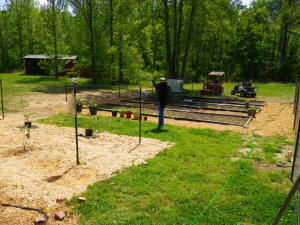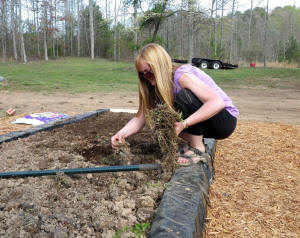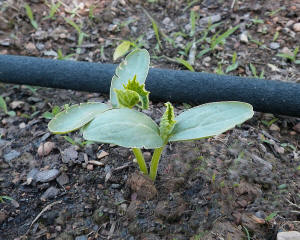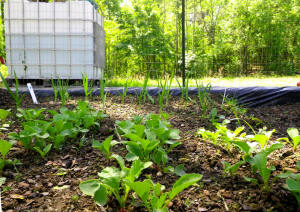April 26 - 2012 - More
When we started this part of our micro farm project, we knew very little about  raised bed gardens. Our parents had gardens when we were children, but as adults, we've never undertaken such a project. Rebecca purchased a book titled Mini Farming: Self-Sufficiency on 1/4 Acre by Bret Markham, and it has proven to be an invaluable resource which I repeatedly reference as the project progresses. Additionally, various gardening blogs, videos, and governmental and educational websites have provided guidance, albeit sometimes incorrect or dated. raised bed gardens. Our parents had gardens when we were children, but as adults, we've never undertaken such a project. Rebecca purchased a book titled Mini Farming: Self-Sufficiency on 1/4 Acre by Bret Markham, and it has proven to be an invaluable resource which I repeatedly reference as the project progresses. Additionally, various gardening blogs, videos, and governmental and educational websites have provided guidance, albeit sometimes incorrect or dated. Being on a shoestring budget, my fir _small.jpg) st big investment was the purchase of 18 used railroad crossties for the sum of $90. They're heavy enough to stay in place and they'll last forever. For peace of mind, I used heavy gauge plastic to create a watertight and airtight barrier between the crossties and the garden bed. I used cheap 1"x 2"s as stakes to hold the crossties in place, then filled and packed dirt between the beds to stabilize them. Shimming with bricks to level the crossties created beds with between 12"- 16" of amended and finely tilled topsoil. After their installation, the 18 crossties established three 24' x 5' beds for a total of 360 square feet of garden space. st big investment was the purchase of 18 used railroad crossties for the sum of $90. They're heavy enough to stay in place and they'll last forever. For peace of mind, I used heavy gauge plastic to create a watertight and airtight barrier between the crossties and the garden bed. I used cheap 1"x 2"s as stakes to hold the crossties in place, then filled and packed dirt between the beds to stabilize them. Shimming with bricks to level the crossties created beds with between 12"- 16" of amended and finely tilled topsoil. After their installation, the 18 crossties established three 24' x 5' beds for a total of 360 square feet of garden space.
Filling three very large beds with dirt could have been quite a chore.
 Fortunately, we have access to my father's tractor equipped with a bucket. It made short work of gathering topsoil from our little cove and placing it in the beds. I designed the beds' width and spacing based on the tractor's wheelbase and bucket width. I can easily drive between and through the beds if necessary. The soil is dark and rich (probably from 22 years of my fertilizer and expensive topsoil running off my lawn). Unfortunately, the dirt is also riddled with fescue sod and clover roots a foot deep. We hand hoed one Fortunately, we have access to my father's tractor equipped with a bucket. It made short work of gathering topsoil from our little cove and placing it in the beds. I designed the beds' width and spacing based on the tractor's wheelbase and bucket width. I can easily drive between and through the beds if necessary. The soil is dark and rich (probably from 22 years of my fertilizer and expensive topsoil running off my lawn). Unfortunately, the dirt is also riddled with fescue sod and clover roots a foot deep. We hand hoed one _small.jpg) of the beds because out tiller was on the fritz. I ended-up renting a small tiller for the next weekend. It was $40 well spent. I added some peat and bagged garden soil to make it a little fluffier and help it hold moisture, then pulverized it. I wanted to add vermiculite, but I couldn't find any locally before planting time. I'll add some next fall. of the beds because out tiller was on the fritz. I ended-up renting a small tiller for the next weekend. It was $40 well spent. I added some peat and bagged garden soil to make it a little fluffier and help it hold moisture, then pulverized it. I wanted to add vermiculite, but I couldn't find any locally before planting time. I'll add some next fall.
With the beds in place, our next concern was protecting
 our hard work from total destruction by our goats and chickens, or by the many deer visitors we receive in our little cove. The best deal I could find was 5' high welded-wire fence. It may seem short to some, but our deer are small than some, and I'm keeping my fingers crossed they'll not be tempted enough to attempt the jump. purchased two 100' rolls of fencing and a dozen or so 6.5' t-posts. I constructed an inexpensive gate using 2" PVC pipe and left-over fencing. Once it was all set-up, it worked great. our hard work from total destruction by our goats and chickens, or by the many deer visitors we receive in our little cove. The best deal I could find was 5' high welded-wire fence. It may seem short to some, but our deer are small than some, and I'm keeping my fingers crossed they'll not be tempted enough to attempt the jump. purchased two 100' rolls of fencing and a dozen or so 6.5' t-posts. I constructed an inexpensive gate using 2" PVC pipe and left-over fencing. Once it was all set-up, it worked great.
With the bulk of the infrastructure completed, we decided to begin
 planting our garden although it was just a little early for some of the plants. This year it's been extremely mild, and everything is about a month ahead. On our first planting, we sowed radishes, garlic, cucumbers, peas, corn, and planted tomato seedlings. A week or so later, we followed-up with lettuce, lima beans, pole beans, okra, squash, zucchini, a variety of peppers, watermelon, cantaloupe, onions, carrots. As of mid-late April, everything is up and looking hardy. We had a three close calls with frost, but we beat the monster (see plastic on the beds). planting our garden although it was just a little early for some of the plants. This year it's been extremely mild, and everything is about a month ahead. On our first planting, we sowed radishes, garlic, cucumbers, peas, corn, and planted tomato seedlings. A week or so later, we followed-up with lettuce, lima beans, pole beans, okra, squash, zucchini, a variety of peppers, watermelon, cantaloupe, onions, carrots. As of mid-late April, everything is up and looking hardy. We had a three close calls with frost, but we beat the monster (see plastic on the beds).
We are slowly learning what is
 good to plant together and what is not. I don't think we made too many bad mistakes this first time around. We are definitely experimenting with the "Three Sisters" planting scheme of squash, corn, and climbing beans and peas. I am also trying a few neat ideas I discovered from the Backyard Farming book and online. For instance, we are training our tomatoes and some of our cucumbers to climb a string trellis to save room in the bed. good to plant together and what is not. I don't think we made too many bad mistakes this first time around. We are definitely experimenting with the "Three Sisters" planting scheme of squash, corn, and climbing beans and peas. I am also trying a few neat ideas I discovered from the Backyard Farming book and online. For instance, we are training our tomatoes and some of our cucumbers to climb a string trellis to save room in the bed.
Ke
_small.jpg) eping the garden watered through our hot dry summers is a top priority, especially when we may be out of town several days at a time. To solve this problem, we purchased a used (like new) 275 gallon water tote (Craigslist $50), a two-zone watering timer, some soaker watering hoses ($11ea), and a variety of adapters and splitters to make it all work. I'm currently experimenting with getting a good even water coverage in all three beds. I may have to add another two-zone watering timer before all is said and done. eping the garden watered through our hot dry summers is a top priority, especially when we may be out of town several days at a time. To solve this problem, we purchased a used (like new) 275 gallon water tote (Craigslist $50), a two-zone watering timer, some soaker watering hoses ($11ea), and a variety of adapters and splitters to make it all work. I'm currently experimenting with getting a good even water coverage in all three beds. I may have to add another two-zone watering timer before all is said and done.
In addition to building raised beds for vegetables, we also used the new fenc
 ed area to plant some grape vines, blueberries, and blackberries. Additionally, we have placed a variety of containerized fruit plants in the enclosure including fig trees, strawberries, and a very hardy cherry tomato (see here blooming in mid-April). ed area to plant some grape vines, blueberries, and blackberries. Additionally, we have placed a variety of containerized fruit plants in the enclosure including fig trees, strawberries, and a very hardy cherry tomato (see here blooming in mid-April).So, will we save money on groceries? Probably not this year. The expense of establishing the garden outweighs the fiscal benefit, at least the first year. Next year will be a different story. We'll have our own compost _small.JPG) (thanks to the goats, rabbits, and all organic kitchen waste), and labor will be minimal compared to this year. We have to remember the other benefits too. In addition to providing the family with fresh healthy food, we're all learning a lot about plants, how they grow, and what they need. I also believe the kids will be much more inclined to eat the veggies they've helped grow. (thanks to the goats, rabbits, and all organic kitchen waste), and labor will be minimal compared to this year. We have to remember the other benefits too. In addition to providing the family with fresh healthy food, we're all learning a lot about plants, how they grow, and what they need. I also believe the kids will be much more inclined to eat the veggies they've helped grow. |
Thursday, April 26, 2012
Micro Farm Update - Raised Bed Vegetable Garden
Subscribe to:
Post Comments (Atom)

This comment has been removed by the author.
ReplyDeleteand slightly off subject, but it you have another area, you might try micro orchard as well.... my grand father even did some grafting, one tree had yellow delicious on one side and red? not sure what type on the other.
ReplyDeleteI pulled up some small seedlings (about a foot tall) that were sticking up in his yard, before cutting the grass around some white peach trees he had, before cutting his grass. I brought two back to Ohio, from Virginia in a couple coffee cups, and one survived and is loaded with fruit about every other year.... we've sinced moved, but the treee is still there.
once we find a place with a few acres, I want to plant a couple each of peach, apple, cherry and maybe pear. my wife's uncle has some PawPaw trees on his land, and I got some seeds last year, but not absolutely sure i want to plant them.... tastes good, but the fruit is loaded with huge seeds throughout (almost quarter sized)
I had decent luck with Yukon Gold potatoes, tomattos and cucumbers, the last two years, but hoping to be moving soon, so haven't planted anything yet this year, although think I'll put together a couple large containers, just in case we don't move as soon as I like.
As far as the money savings this year, plant some of the more expensive stuff to speed up the payback. And save seeds for next year, so you don't have the added expense of buying more next year.
ReplyDeleteThanks for the feedback. We really want to add some fruit trees as well as some other long-term items as time permits. We plan to add another bed in the fall too. My next project is getting my greenhouse up and going, and installing my 400 gallon fish farm for some aquaponics experimentation.
Delete